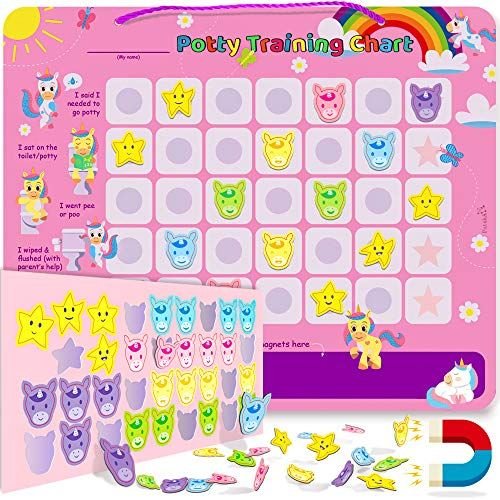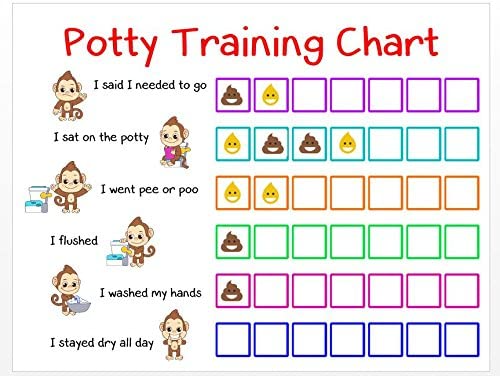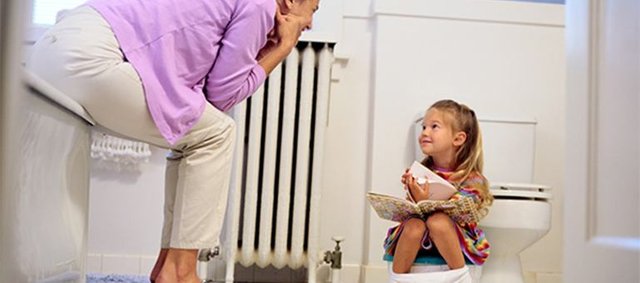Secrets to Successful Potty Training
To assist you with your little one's potty training journey, we've created a list of toilet training recommendations for your toddler:
1.Ascertain that your youngster is prepared.
Try not to hurry the process and start toilet training your child before he or she is ready. Before you start toilet training your child, look for indicators that he or she is ready.
2.Participate in the selection of the potty with your child.
If at all feasible, shop for a toilet chair or potty seat with your child. It will make him feel more included, and he will be more eager to use his brand-new potty.
3.As a token of support, purchase big kid underpants.
Purchase amusing underwear, such as those with a favorite cartoon character or superhero. Explain to your child that he can wear this wonderful big kid underwear once he learns to use the potty. You may also use these underwear as a reward when he's toilet training. Just be ready for a few toilet mishaps.
4.Put the potty in an accessible location.
Although the bathroom is the most apparent place (and placing it there may help your kid understand that going potty happens in the bathroom), you can also consider placing the potty in your child's bedroom for convenient access after naps, or in the playroom.
5.Put yourself on a potty routine.
Once your little one starts potty training, implement a simple schedule. You may, for example, promote going pee after meals or nap time. This teaches your youngster that going potty is a normal part of life.
6.Track (and reward) progress with a sticker chart.


Allow your child to add a sticker on the chart every time he/she does a nice job on the potty.Every time he/she gets a new sticker, he/she will be overjoyed.
7.Make a song about going potty.
If your youngster is hesitant to use the potty, some musical encouragement may help him feel more at ease and get into the swing of things. You may sing the song along on your way to the potty or while he is using it. You may find a lot of song ideas on the internet, or you can make up your own little ditty.
8.Praise your child constantly.
Tell your child when he/she does a nice job on the potty. You may also offer him/her a high-five or a hug, or anything else works to keep his/her spirits up and remind him/her that he/she is doing a fantastic job.
9.Obtain a book for your child.
While your child is on the potty, read him a book on going to the bathroom or allow him to look at one of his favorite picture books to help him pass the time and relax.
10.Have some nude time.
This method of potty training is used by some parents. The main premise is that allowing your child to be nude at home encourages her to use the potty because she won't be able to go into a diaper. This strategy may be especially beneficial for youngsters who are still having trouble pulling down their training pants to use the potty. This method may work best during the summer months, but it may not work for every child, as with all of the recommendations in this article.
11.Before going to bed and after waking up, potty train.
Taking your baby to the potty before she goes to bed and as soon as she wakes up in the morning is a wonderful idea. You may also take her to the potty if she wakes up in the middle of the night. Showing her how to go to the bathroom at regular intervals can help her develop healthy habits and may also help her avoid nighttime accidents.
12.Set a good example.
Take your child to the bathroom with you the next time you have to go, and show her how simple it is to pee and defecate. Dads could find it simpler to educate small males, while parents might show girls how to do it. There is no hard and fast rule, so do what works best for you and your family.

13.Magic tricks.
Fill your toilet bowl with blue dye (or just blue toilet bowl cleaner). The color of the toilet water will shift from blue to green while your child pees. Dish soap can be added to the toilet as an alternative. When your youngster pees, he'll enjoy watching the froth and bubbles rise to the surface.
14.Instead of promoting the use of the potty, consider encouraging the use of the toilet.
Instead of promoting the use of the potty, consider encouraging the use of the toilet.
Instead of a standalone potty, you might choose to start your child on a toilet with a child seat. If this is the case, emphasize the concept that grownups use the bathroom and that this is a terrific opportunity to perform "grown-up" activities. A step stool or footstool will make it easier for him to reach the toilet while also assisting him in maintaining his balance.
15.Allow some more time for your son.
Boys and girls may require more time to understand the difference between executing a number 1 and a number 2. It's a good idea to start with teaching him how to urinate while seated before moving on to standing.
16.Encourage your son by doing target practice.
You may start teaching your son how to aim whenever he's ready to begin peeing standing up. Dropping an O-shaped cereal piece into the toilet bowl or potty is one way to accomplish this. Encourage your son to shoot. Positive reinforcement will come from the satisfaction of meeting the goal.
17.Make it less frightening to poop.
Passing a bowel movement might be frightening for your child. His apprehension may lead to withholding, which might result in constipation. It can be difficult to pass firm stools, and your youngster may connect pooping with pain. Teach your youngster that pooping is a natural function and that there's nothing to be scared of (maybe by viewing a cartoon on the subject or reading him a children's book on the issue).
18.Show and tell[ is a technique used to demonstrate something].
Acting out a "going to the restroom" scene is another strategy. Act out how the doll uses the toilet or potty using a cherished doll or teddy bear. To reinforce the lesson, ask your youngster to show you how the doll goes potty.
19.Don't immediately flush.
If you're training your youngster to use the potty, don't flush shortly after he or she has used it. In the early phases of toilet training, the flushing sound might be particularly frightening. Introduce the notion of flushing gradually, possibly after your toddler has mastered the art of toilet training, and turn it into a joyful game – somewhat like letting your child press an elevator button.
20.In a few days, don't anticipate miracles.
Some parents swear by 3-day toilet training, which is similar to a potty training boot camp in which the training is rigidly timed. Although this may work for some parents and children, it is not for everyone.
21.Experiment using reverse psychology.
If your youngster is having trouble adjusting to the notion of using the potty or just refuses to do so, you might want to attempt some reverse psychology. You may, for example, politely inquire if she prefers to remain in diapers even when she is a big girl. The key to success with this strategy is to avoid putting too much stress or pressure on your child, since this might backfire and make her even more resistant to toilet training.
22.Punishing errors is not a good idea.
Despite the fact that potty training challenges might be unpleasant, avoid the impulse to become upset or discipline your child. Instead, tell her it's fine and that she may try again later. Putting her under more stress will not help her learn quicker. It's also possible that your child isn't ready yet, in which case you should postpone toilet training for a few days or weeks.
23.Regression is a possibility.
You can reach a snag or experience difficulties when potty training. This is a very normal and healthy aspect of the learning process. If this happens, don't be disheartened. Patience is required. Attempt a different method. Allow time to pass.
CLICK HERE TO ACCESS SECRETS TO SUCCESSFUL POTTY TRAINING-
https://www.digistore24.com/redir/341870/HESBON/